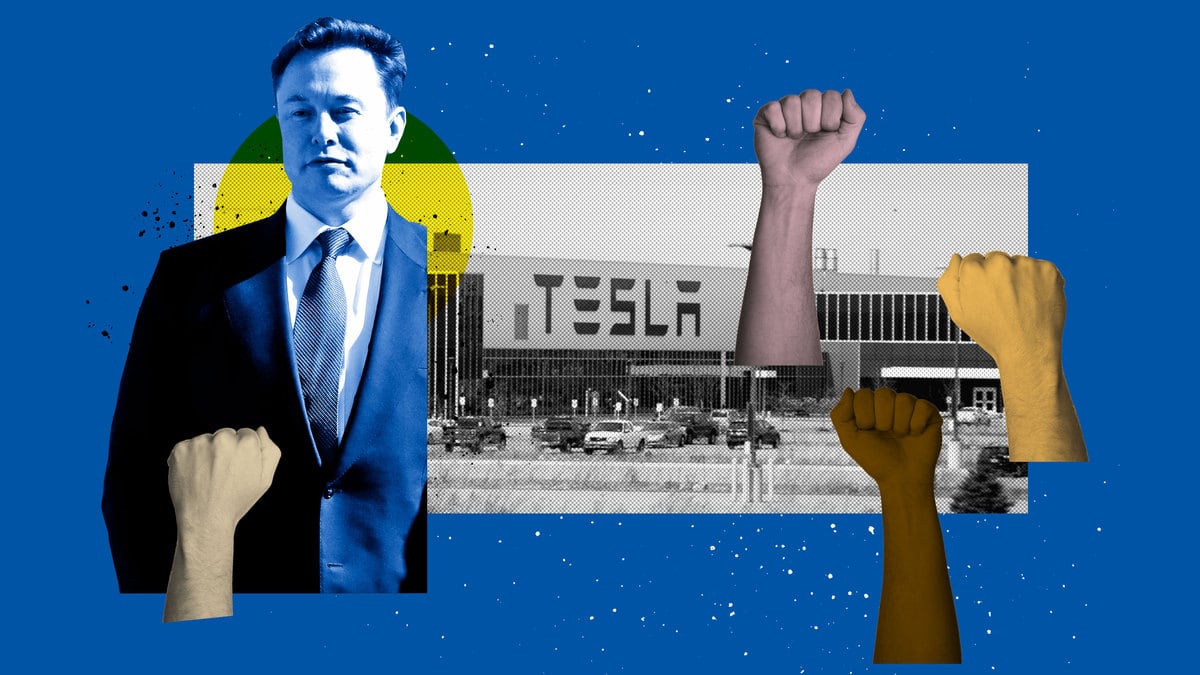There was a palpable buzz in the air at Tesla’s Gigafactory 2 in Buffalo, New York, this Valentine’s Day—but it had nothing to do with romance.
On Feb. 14, 25 autopilot department employees launched a union campaign months in the making by distributing Valentine-themed leaflets to their coworkers. Within hours, the media had picked up the story, and Tesla Workers United was making headlines across outlets.
“It was electric,” Tesla employee and organizing committee member Alex Whetham told The Daily Beast. “It was a feeling I hadn’t had at Tesla in some time.”
That electricity didn’t last long, though. Over the next two days, tensions skyrocketed as Tesla fired an estimated 40 employees—out of nearly 800 at the plant—without warning. Management walked through the factory, tapping employees on the shoulder and pulling them into private meetings before sending people with boxes to clear out their desks, organizers said at a Feb. 18 press conference.
Tesla insisted the firings were due to performance issues, but employees weren’t buying it.
“The firings are messages that are obviously being sent, fearing for your job, your security.” employee and organizing committee member Will Hance told The Daily Beast. “There were a few rough days there.”
Steven Greenhouse, a longtime labor writer and expert, called it “clear retaliation.”
“If you were a company that did not want to appear anti-union, even if the firings were scheduled, you would never carry them out the day after a union is announced,” he told The Daily Beast.
Tesla did not respond to The Daily Beast’s request for comment. Notably, Tesla disbanded its media relations department in 2020.
The idea for Tesla Workers United was initially sparked by the company’s response to a wave of severe winter weather that first hit Buffalo in late November, according to Hance, who said that Tesla—despite having closed the factory due to hazardous snow conditions—said employees must either take the day unpaid or use accrued paid time off to receive compensation. Hance said that a new policy surrounding factory closures and compensation is a central demand of the union.
Employees have also expressed concerns about the way Tesla monitors worker productivity on a day-to-day basis. The company uses software to track employees’ keystrokes down to the second, which can be unreliable and cause unnecessary stress for workers, employee and organizer Keenan Lasch said at the press conference.
“This seems to be one of the first instances where white collar workers in the U.S. are standing up and unionizing because they’re so frustrated with and anxious about this constant monitoring,” Greenhouse said.
Yet, it appears that quite a lot stands between these workers’ demands and their ultimate fruition. Their biggest obstacle?
The key to unionizing at a company headed by one of the richest, most powerful, and staunchly anti-union CEOs in the world? Not giving him a second thought, apparently.
“I don’t really care that much about Mr. Musk, to be frank,” Hance said.
Whetham agreed: “While it is scary to go against Elon Musk, it is something that has barely even crossed my mind. Currently, our strategy is not one that has Musk at the front of our minds at all times.”
Their main drive may not be to stick it to their CEO, but these organizers still face a formidable opponent. While the autopilot employees began their mission in November, this isn’t Tesla’s first encounter with union efforts.
In October 2017, Tesla fired union activist Richard Ortiz after he distributed pamphlets at a Tesla office in Fremont, California. In 2021, the NLRB upheld a ruling that Ortiz had been illegally fired and required Tesla to reinstate him with back pay. The board also ordered Musk to delete a 2018 tweet—“why pay union dues & give up stock options for nothing?”—labeling it “unlawfully coercive.” The NLRB then told Tesla to post a notice of employees’ right to organize at their locations across the U.S.
Last year, Musk challenged United Auto Workers to hold a vote at Tesla, arguing the company has no choice but to pay its workers well or risk losing them.
“I’d like hereby to invite UAW to hold a union vote at their convenience,” Musk tweeted. “Tesla will do nothing to stop them.”
Employees under Musk have alleged retaliation for speaking up about workplace conditions even outside of union organizing efforts. In November 2022, employees at Musk’s SpaceX drafted a letter to the tech giant condemning his tweets regarding sexual assault allegations made against him in 2018. SpaceX fired nine employees soon after the letter circulated; eight then filed with the NLRB alleging their termination was retaliatory.
For Greenhouse, Musk’s history, combined with recent union trends, means these autopilot organizers have a tough challenge ahead of them. “The unionization effort at Tesla will face the exact same problems as the ones at Starbucks,” he said.
Starbucks employees have made a push to unionize 100 stores across the country in the last 18 months. With this came dozens of terminations, which workers allege was retaliation. As of this month, the NLRB has filed 24 complaints involving 50 former employees alleging Starbucks illegally fired them in retaliation for organizing activity.
Just last week, a Michigan federal judge placed an injunction on all Starbucks stores, banning them from firing any employees due to organizing efforts; however, on Thursday the judge issued a correction and limited that to just a single store in Michigan, where a worker claims she was fired in retaliation for union activity.
Greenhouse also cited the fact that NLRB cannot issue fines beyond ordering backpay or other compensation as a concern for organizers.
“That lack of penalties gives real incentives to companies like Starbucks or Tesla to fire people illegally when they unionize,” Greenhouse said. “That makes it very hard.”
Yet, despite these odds, Tesla organizers aren’t backing down.
While they may face a fierce opponent, Tesla autopilot workers said they remain determined to gain autonomy in their workplace.
One key to this movement, Hance said, is organizing with Workers United. An affiliate of the SEIU, Workers United has about 86,000 members across multiple sectors, including food service, fitness, hospitality and non-profit. They gained particular notoriety last year as the parent union for Starbucks organizers.
Hance, who has been a part of the organizing committee since its inception, said Workers United was a “clear” decision for organizers.
“The thing that drew us to Workers United was their very intensive focus on complete autonomy,” Hance said. “It’s not like United Auto Workers or a huge, company-esque, multi-million employee union. They’re a huge union, certainly. However, they break it up into local unions, meaning people who are in the union get to determine what everything looks like. You aren’t handed down anything, you create everything.”
Whetham told The Daily Beast he didn’t decide to join the organizing committee until Feb. 13.
“When I found out it was Workers United that was going to help us come to fruition, that was one of the main reasons I so eagerly joined,” Whetham said.
Jaz Brisack, an organizer with Workers United who worked closely on the Starbucks union campaign while employed as a barista with the company, said that the union emphasized worker autonomy at both Tesla and Starbucks.
“They are both very worker-driven campaigns, emphasizing strong organizing committees and local autonomy, which I think is the secret—or not-so-secret—requirement of organizing,” Brisack told The Daily Beast.
Lizzie McKimmie—a Tesla employee and organizing committee member—said that while the fear of termination is very real, her love for the job and a desire to make it better meant the threat was worth it.
“I’m a single mother, I live by myself in an apartment. I’m paycheck to paycheck,” McKimmie said at the press conference. “So the fear that at some point I’m going to lose it over something that I can’t really control, is scary. But I am willing to lose it—I want what’s best for everybody.”
For Hance, the opportunity for greater autonomy at work is what makes the uphill battle well worth it.
“It really is just about having control over our lives,” he said. “It feels really bad when you don’t have that.”
Tesla Workers United is now taking multiple courses of action. They are primarily calling on the company to sign the Fair Elections Principles; they then hope to work towards a union vote. Organizers are also awaiting word from the NLRB on a charge they filed Feb. 15 accusing Tesla of retaliatory firings.
“The Union seeks injunctive relief under Section 10(j) of the Act to prevent irreparable destruction of employee rights resulting from Tesla’s unlawful conduct,” the charge reads.
Section 10(j) of the National Labor Relations Act allows for the NLRB to pursue temporary injunctions against employers while the case is still being litigated. Tesla Workers United is seeking for these employees to be reinstated with back pay.
Tesla Workers United has also expanded their membership beyond the autopilot department, having won over some factory floor workers as well, employee and organizer Al Celli said at the press conference.
As they continue to spread the word and wait for a potential vote, Brisack said the union feels pressure from the community will likely work in their favor.
“It actually means it’s a very risky move for Tesla to respond the way they’re responding to our union campaign,” Brisack said. “They don’t need additional public scrutiny and public criticism. They need to be reassuring people that they’re stable and that their customers aren’t going to stand for this.”
“Their whole corporate mission is sustainability and a just transition,” Brisack added. “You can’t have those things without providing sustainability and justice for workers.”
Tesla consumers may play a role in how Tesla responds, according to Greenhouse.
“Many Tesla consumers see themselves as good liberals who buy electric cars to fight climate change,” Greenhouse said. “So these progressives are buying from a company they see as progressive, but it’s as anti-union as the most conservative companies in America.”
Regardless, Tesla Workers United has a long fight ahead of them—a fight, Brisack said, that they believe can be won with cooperation between workers.
“I think we’re under no illusions about what we’re fighting for and what Tesla will do, but workers fighting together can overcome anything companies throw at people,” Brisack said.







